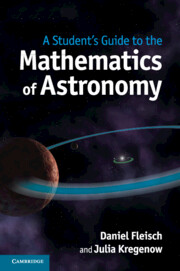6 - Black holes and cosmology
Published online by Cambridge University Press: 05 June 2014
Summary
Two of the most popular topics in astronomy classes are black holes and cosmology. Both of these subjects can be somewhat abstract, hard to visualize, and quite mathematical, giving them a mystique which likely contributes to their popularity. Precisely because some of the objects and processes are hard to visualize, the mathematical foundations of these topics are a valuable source of insight into their nature. So for these topics, even more than for other topics for which you have physical intuition on your side, it behooves you to understand the mathematics.
This chapter deals with “limiting cases” by investigating the mathematical ramifications of taking one variable to an extreme, such as allowing the radius of an object to shrink to zero or permitting time to run to infinity. The physical manifestations of these mathematical limiting cases lead to the most exotic concepts in astronomy: black holes, which are singularities of mass; and cosmology, which deals with the history and fate of the Universe. The chapter draws upon many of the tools discussed previously in this book, including units, solving equations using ratios and the absolute method, gravity, light, and graph interpretation. Black holes and cosmology bookend the entire range of possible sizes, from the infinitesimally small to the unimaginably immense, and are well worth the investment of time it takes to understand their mathematical foundations.
Before diving into black holes, you should make sure you have a solid understanding of the concepts and equations related to density and escape speed. Those are the subjects of the first two sections of this chapter, so if you're already comfortable with those topics, you can jump ahead to Section 6.3.
- Type
- Chapter
- Information
- A Student's Guide to the Mathematics of Astronomy , pp. 152 - 190Publisher: Cambridge University PressPrint publication year: 2013

